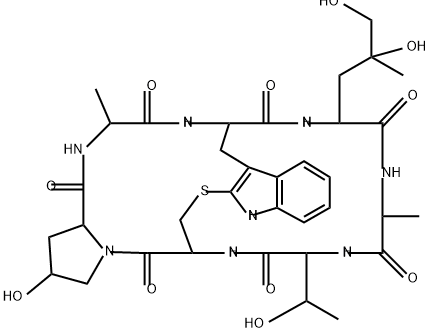All AbMole products are for research use only, cannot be used for human consumption.

Phalloidin is a mushroom-derived toxin which can be used to label F-actin of the cytoskeleton with fluorochrome (λex=495 nm, λem=520 nm). Phalloidin staining will not work with methanol-fixed cells, probably because of the disruption of actin filament integrity, but it will work with cells fixed in 0.2% glutaraldehyde in PBS. For fluorescein isothiocyanate (FITC)-Phalloidin (or rhodamine isothiocyanate [RITC]-Phalloidin), the excitation wavelength maximum will be near 495 nm (or 550 nm) and the emission wavelength maximum will be ~520 nm based on H2O at pH 8.0 as the solvent (575 nm with methanol as the solvent). The emission spectrum of fluorescein can depend on the environmental pH and/or ionic strength.
| Molecular Weight | 788.87 |
| Formula | C35H48N8O11S |
| CAS Number | 17466-45-4 |
| Solubility (25°C) | Water |
| Storage | -20°C, protect from light, dry, sealed |
[4] H Faulstich, et al. Adv Exp Med Biol. New aspects of amanitin and phalloidin poisoning
[5] J A Cooper. J Cell Biol. Effects of cytochalasin and phalloidin on actin
| Related Fluorescent Dye Products |
|---|
| Copper probe CF4
Copper probe CF4 (Copper fluor CF4) is a Cu+-specific fluorescent probe based on a rhodol dye scaffold. Copper probe CF4 (Copper fluor CF4) has high copper selectivity with a Kd value of 2.9×10-13 M, particularly over zinc and iron, as well as abundant cellular alkali and alkaline earth metals. Copper probe CF4 (Copper fluor CF4) is stable in a physiologically relevant pH regime between 6 and 8 (wavelengths of 415 nm for excitation and 660 nm for emission). Copper probe CF4 (Copper fluor CF4) can be used to study colon cancer. |
| Phalloidin-Fluor 647 Conjugate
Phalloidin-Fluor 647 Conjugate selectively binds to F-actins. Used at nanomolar concentrations, phalloidin derivatives are convenient probes for labeling, identifying and quantitating F-actins in formaldehyde-fixed and permeabilized tissue sections, cell cultures or cell-free experiments. |
| HBC530
HBC530 is a GFP fluorophore-like synthetic dye, with a structurally rigid electron acceptor and a strong electron donor. HBC is nonfluorescent in solution, and when combined with Pepper (RNA aptamer), HBC forms a tight complex and activates and emits bright fluorescence (Kd of ~3.5 nM). HBC emission peaks vary in different complexes and covers the spectrum from cyan to red. HBC can be used in the live cell imaging of RNA (Em/Ex = 530/485 nm). |
| 2',7'-dichlorodihydrofluorescein
2,7-Dichlorodihydrofluorescein (DCFH2) is a non-fluorescent reactive oxygen species (ROS) probe with an excitation wavelength of 485-500 nm and an emission wavelength of 515-530 nm. 2,7-Dichlorodihydrofluorescein is first hydrolyzed by intracellular esterases and then oxidized by ROS to generate non-biomembrane-permeable, highly fluorescent 2,7-dichlorofluorescein (DCF). 2,7-Dichlorodihydrofluorescein can undergo oxidation reactions with a variety of ROS (such as ·OH, H2O2, ONOO-, etc.) and is used to quantitatively detect the level of oxidative stress inside and outside cells. The fluorescence intensity of DCF is positively correlated with the ROS concentration. |
| 4-MUNANA
4-MUNANA is a substrate of influenza virus neuraminidase (NA) with high selectivity and irreversible reaction. In the enzymatic reaction, 4-MUNANA is hydrolyzed by NA to generate fluorescent 4-methylumbelliferone (4-MU). By detecting the fluorescence intensity of 4-MU, quantitative analysis of NA activity can be achieved. |
All AbMole products are for research use only, cannot be used for human consumption or veterinary use. We do not provide products or services to individuals. Please comply with the intended use and do not use AbMole products for any other purpose.


Products are for research use only. Not for human use. We do not sell to patients.
© Copyright 2010-2024 AbMole BioScience. All Rights Reserved.
